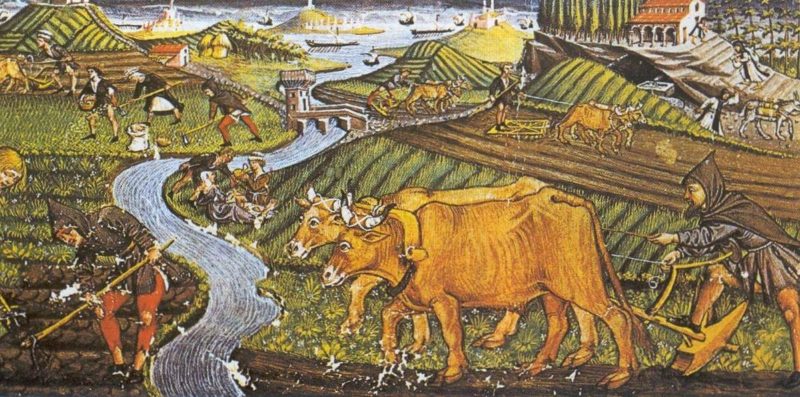We explain what the large estate is, how it originated and what are its causes. In addition, its general characteristics and what is a smallholding.
What is the Large Estate?
The large estate is a large agricultural exploitation , usually privately owned and with a lower productive yield than the land allows, low capitalization and a precarious workforce. Considerations regarding the minimum dimensions of a large estate, however, may vary according to the region and culture .
The term large estate contains a pejorative charge, linked to the inappropriate or inefficient use of the lands and a private management more interested in owning them than in producing food for the population .
In fact, the term “latifundia”, which is used to name the person who practices the large estate, is usually associated in Latin America with the large landowners heirs of the elites who held land ownership in colonial or post-independence times.
However, in strict terms, a large estate can be administered by any community , and even be part of collective or communal production projects.
Large estate etymology
The word large estate comes from the Latin latifundium , which already in its time translated as a wide extension ( latus ) destined to serve as the base or root of something ( fundus ). This last word shares origin with words related to economics such as “funds”, which shows its early link with the accumulation of properties and stately power.
History of the large estate

The first large estates in history occurred in the Roman Empire , in which citizens were distinguished between those who possessed land and the proletarians , that is, those who could only contribute their offspring, their descendants, to the State . These large estates were administered by imperial agents, who guaranteed certain local production monopolies through the bureaucracy .
The arrival of the Middle Ages , however, changed the social and political system so radically that it was the nobles and aristocrats who owned the lands who controlled the plots of the so-called feudal society (of fiefdom), in which each feudal lord had his own. Large estate controlled by the military and hosted in exchange for protection and a portion of the food produced by the working peasants.
The arrival of the Modern Age did not eradicate the large estates, in fact the conquest of America basically consisted of the distribution of lands to colonize and make productive for the benefit of the European metropolis. Over time the slaves who worked on these estates were replaced by peons , in a system similar to the feudal, and then by free workers as democracy gained ground .
However, the large landowners remained largely untouched by system changes.
Accumulation of land
Large estates are the product of the desire to accumulate land as a sign and source of wealth . This has prevented the large estate from becoming a land exploitation system that produces social wealth, since being large tracts of land it would have to massively produce and lower the costs of the merchandise produced in the local market . However, this has not been the case historically, and that is why many societies are dedicated to fighting or alleviating large estates to avoid land monopolies.
Essential features of the large estate

The large estate presents the following typical features:
- Large tracts of land with the same or the same owners.
- Productivity dispersed, high – volume but well below the maximum capacities of the exploited land.
- Labor employed in precarious conditions, and therefore low standard of living.
- Little capitalization of what is produced, and therefore low competitiveness in the markets.
- Low technological level involved in sowing and harvesting.
Causes of large estates
The causes of large estate are historical. The division of conquered lands among military elites , for example, was a common practice in the conquest of the American continent that was preserved by later independent republics. Thus, being transmitted from generation to generation, the large estates were preserved intact despite the growing food needs of the population.
Socioeconomic characteristics of large estates

Landlordism has contributed to the underdevelopment of nations where it is an abundant phenomenon, by impoverishing the peasant labor force and weakening the national agrarian system.
It is linked, in fact, with the sectors of the third world with less agricultural development, and therefore it is fought either with new systems of land ownership (agrarian reform) or with the modernization of agriculture (market agriculture) .
Political implications of the large estate
Unequal land management conflicts with many political provisions that seek to democratize or socialize agriculture in order to build a wealthy and productive peasant class.
Considering it contrary to the social interest, many countries have outlawed it since it forces nations to import food as the only way to combat the food monopoly of a rural elite, which would thus have political and economic influence on governments .
Legal implications of the large estate

Numerous political constitutions and models of government have historically opposed large estates , especially in the nations that have suffered the most, such as Latin America.
In this sense, the legal norm regarding large estates always ensures the preservation of the rights of peasant workers , a weak part of the agricultural link, as well as the incorporation of an ecological conscience in them.
Smallholding
A concept similar to the large estate is the small estate, a variant of much smaller size and extension but the same productive incapacity and of the same private mood. It should not be confused with subsistence agriculture, since the small estate and large estate can both be considered as “idle” lands.
Differences between large estate and small estate

The differences between the large estate and the small estate are the following:
- Different land extensions. The large estate extends over wide, preferably flat lands, while the large estate takes place in small agricultural enclaves, such as mountainous terrain .
- Different work capacity. Although both are considered unproductive forms of land distribution, the smallholding due to its small size lacks the possibilities of large-scale agricultural development, thus segmenting the land into small unproductive plots.
- Different origins. While the large estate is the historical inheritance of certain powerful social classes of hierarchical lineage, the smallholding is usually the result of the division of large estates into smaller properties, as a consequence of inheritance distribution or other succession obligations.
The above content published at Collaborative Research Group is for informational and educational purposes only and has been developed by referring to reliable sources and recommendations from technology experts. We do not have any contact with official entities nor do we intend to replace the information that they emit.














